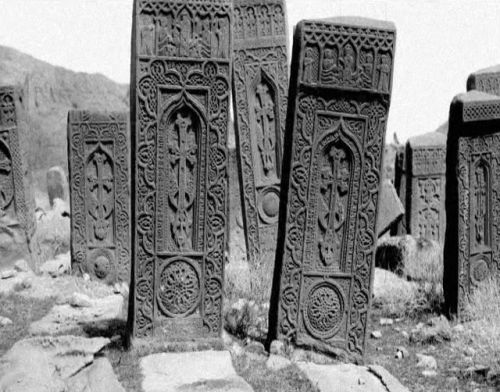Recently, the American Ambassador to Azerbaijan tried to visit the Julfa cemetery in Nakhchivan. Baku did not allow him to visit. Unsurprisingly, the Armenian National Committee of America is not happy.
The city of Julfa was destroyed in the early 1600s, but while the city was laid to ruins, the cemetery remained intact for hundreds of years. The ancient cemetery was filled with thousands of khachkars. Alexander de Rhodes estimated 10,000 khachkars when he visited in 1648. By the 20th century, only about 6,000 survived, with a portion visible in this photo from 1819. Those 6,000 were systematically destroyed by the Azeri government. A more extensive history of Julfa and its destruction is available in this youtube video.
In 1998, the Azeri government ordered the destruction of the cemetery, pausing only temporarily because of mounting international pressure. UNESCO and others criticized the cemetery’s destruction, but by 2005, the cemetery was completely annihilated. Azerbaijan is known to have broken khachkars and used them as building stones in other regions. Some claim Azerbaijan did this with Julfa as well. Azerbaijan has blocked people from visiting Julfa, but AAAS confirms the cemetery’s destruction through satellite imagery comparison and UNESCO confirms the cemetery was destroyed by Azeri soldiers. All that remains now is rocks.
Frustratingly, cultural preservation has been a part of international humanitarian law for decades. The Convention for the Protection of cultural Property in the Event of Armed Conflict came into force in 1956 and was ratified by both Armenia and Azerbaijan in 1993. Article 4.1 states that signatories will “respect cultural property situated within their own territory … by refraining from any use of the property … for purposes which are likely to expose it to destruction or damage in the event of armed conflict; and by refraining from any act of hostility directed against such property.” First, Armenia and Azerbaijan were (and still are) at war during that time, thus one can argue that the armed conflict criterion is met. Second, the final element “refraining from any act of hostility directed against such property” seems to be clearly violated by Azerbaijan ordering its soldiers to destroy the property.
Defense of cultural preservation has gained traction recently on both a “rights” sense and an economic one. When the Ansar Dine destroyed the historical sites in Timbuktu, the ICC Prosecutor called the actions a war crime that her office would investigate. In Armenia, the President has been meeting with the World Tourism Organization to see how to promote tourism and protect the cultural heritage.
While this post has come off as heavily against Azerbaijan, Armenia and Armenians have also damaged Azeri cultural artifacts. After a google search, the desecration of the mosque in the city of Agdam appears to be the largest modern complaint. While the complaint is justified, Agdam’s mosque is not being actively destroyed; it has simply been abandoned with the rest of the city of Adgam. In comparison, the government of Nagorno Karabakh has done some work to restore the two mosques in the city Shushi, even if there is still a lot more work to do. Equality is better demonstrated in the similar fates of the small Armenian and Azeri cemeteries that were purposefully damaged as their populations shifted to be on the “right” side of the border.

